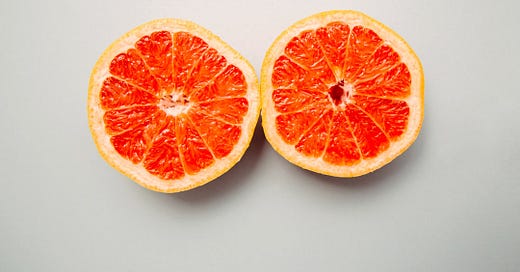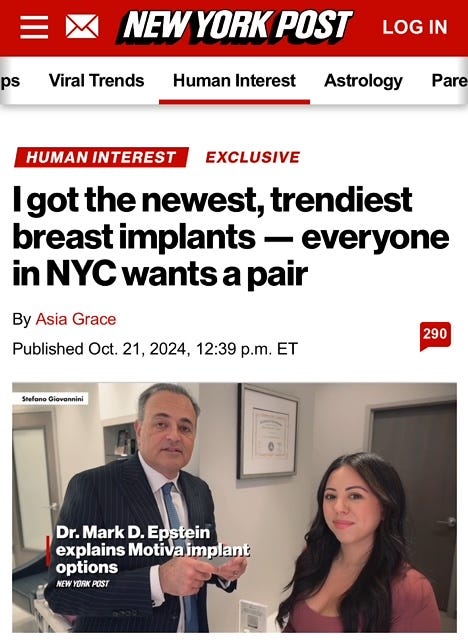A Safer Breast Implant?
Plastic surgeons weigh in on the newly FDA-approved implant that's sweeping social media
My Instagram feed, like most, is a very specific kind of echo chamber—an admittedly unreliable barometer of broader human interest—and lately, it’s been seized by plastic surgeons (and Meghan Trainor) promoting Motiva breast implants.
Last summer, I mentioned these 6th-generation silicone implants in this story, but only in brief, because at the time, the implants were still unapproved in the United States. (They’ve been used elsewhere in the world for more than a decade.) On September 26, the FDA green-lit the Motiva SmoothSilk Implants from Establishment Labs—and surgeons have been buzzing about them ever since.
Patients, too, if you believe the New York Post:
“There are unique aspects of this implant captivating the public and plastic surgeons,” says Steven Teitelbaum, MD, a board-certified plastic surgeon in Santa Monica and an investigator on the 10-year Motiva clinical trial. He points to two attributes, in particular, that set Motiva apart from its predecessors:
The feel of the implant: “The gel is more compressible and stretchable; it better mimics a body’s own tissue,” he says. And unlike other implants, which have an outer shell encasing a gel filling, the Motiva is a cohesive unit—a fusion of shell and gel. “It feels like one entity rather than a shell filled with something,” Dr. Teitelbaum says. “Once a patient puts it in their hand, they immediately notice a difference—it isn’t subtle. I offer all [brands of] implants, but when patients feel the Motiva, they always choose it.” The implants come in two styles: the Round maintains fullness at the top of the breast; the Ergonomix delivers a more natural, less augmented look.
The body’s reaction to the implant: More biocompatible than older models, “the surface of the implant elicits very little reaction, so the body doesn’t get inflamed and build a thick capsule,” Dr. Teitelbaum says. (Capsule = scar tissue that forms around every implant as a normal part of the healing process.) “Since the tissue around the implant remains thin and pliable, and since the device itself is soft, these implants can be nearly undetectable.”
The surface of the Motiva is, in fact, so distinct, it defies conventional descriptions. Breaking with breast-implant tradition, “the FDA has not categorized it as ‘smooth’ nor as ‘textured,’” Dr. Teitelbaum explains. The Motiva surface actually constitutes an entirely new third category called 4-micron, “but it behaves like a smooth in that there are no interstices into which bacteria can reside; it does not shed particles; and it has very low friction against the surrounding tissues,” he says. “These factors lead to less inflammation and fibrosis, and consequentially a softer capsule.”
The topography of the surface—the height of its fine peaks and the precise distance between them—ensures immune cells “do not recognize the implant as a foreign object they want to encircle and remove,” Dr. Teitelbaum says. Again, less immune reaction begets less inflammation—and a lower risk of capsular contracture, which occurs when the scar capsule thickens and tightens, potentially distorting the breasts and causing discomfort.
A common complication of breast augmentation, “capsular contracture is the result of technical factors, patient biology, and the surface of the implant,” says Dr. Teitelbaum. “In creating an implant surface that mollifies abnormal capsule formation, Motiva has almost completed solved that problem with this implant.”
Indeed, the Motiva clinical trial reported an “unprecedentedly low” capsular contracture rate of .5% at 4 years, notes Troy A. Pittman, MD, a board-certified plastic surgeon in Washington, D.C. and New York City. He, too, describes the implant as a problem-solver. For years, he tells me, surgeons have been evolving and modifying their techniques to make up for inherent implant shortcomings, “but this is really the first time the implant is solving problems for us.”
And not just capsular contracture. By thwarting bacterial colonization, the implant may minimize the risk of anaplastic large cell lymphoma (ALCL), a cancer of the immune system associated primarily with textured breast implants. (Read more about ALCL here.) “There are over 3 million Motiva devices out there in the 88 countries that had the approval before the United States, and there has never been a case of ALCL,” says Dr. Pittman. “No other implant manufacturer can say that.”
The rupture rate for Motiva is also exceedingly low at .6%. What’s more, the rheology of the gel coupled with the fact that the implant is 100% filled reportedly translates to less rippling, adds Dr. Pittman—meaning you’re less apt to see the implant through the skin when it’s positioned on top of the pectoralis muscle. This is a boon to surgeons who prefer to place implants in this “prepectoral” plane instead of cutting the muscle and hiding them behind it. (Rippling has long been considered a drawback of over-the-muscle techniques. For more on the over vs. under debate, see here.)
Dr. Pittman says Motiva implants lend well to an over-the-muscle technique called preservation breast augmentation. Hallmarks of the approach include minimal dissection, a sparing of the breast ligaments, a “very tight pocket” to steady and support the implants, and zero muscle disruption. He finds that the operation affords a “perky” result, a speedy recovery, and a comfortable long-term outcome with no strength-training restrictions. (Some surgeons discourage women with implants under the muscle from working their pecs due to worries of animation deformity—the implants visibly moving as the muscle contracts—and other issues.) While Dr. Pittman performs the preservation technique on a range of patients, he says the slimmest of women, who have little to no natural breast tissue, generally still fare better with implants behind the muscle. “I cannot see a world where putting any implant on top of the muscle in a super-thin patient won’t make her look like she has two soup bowls on her chest,” he says.
As Motiva implants find their way into operating rooms across the country, “a big question for plastic surgeons and women, in general, is whether the improved feel and reduced complication rate will entice patients on the fence about breast implants to finally get them,” says Dr. Teitelbaum. “Only time will tell, but based on what patients are saying, there are likely some women feeling this way.”
Dr. Pittman has gotten a similar sense from patients. Recently, he’s fielded consultation requests from women who have, in the past, expressed concerns over implant safety and breast implant illness (a collection of symptoms that some patients and doctors attribute to implants).
Less than a year ago, Dr. Pittman saw interest in breast augmentation waning. “And those who were coming in for it were almost apologizing for wanting a breast augmentation, because implants had such a bad reputation,” he says. But, lately, breast augs are up in his office. And he predicts that the procedure will soon reclaim the top spot in the ASPS rankings, after being dethroned by lipo a few years ago.
Is Motiva—this seemingly safer implant—helping to reform the image of breast augmentation at large? It’s unlikely, since the device is brand-new to most Americans, but who really knows? I’d love to hear what you think, so please take to the comments—and don’t forget to tap that little heart button on your way out. xx






